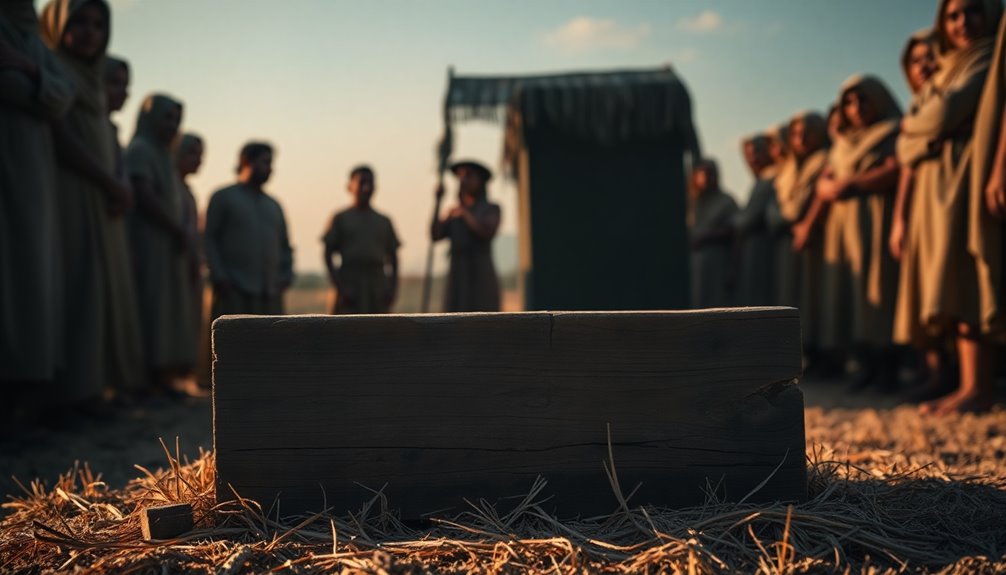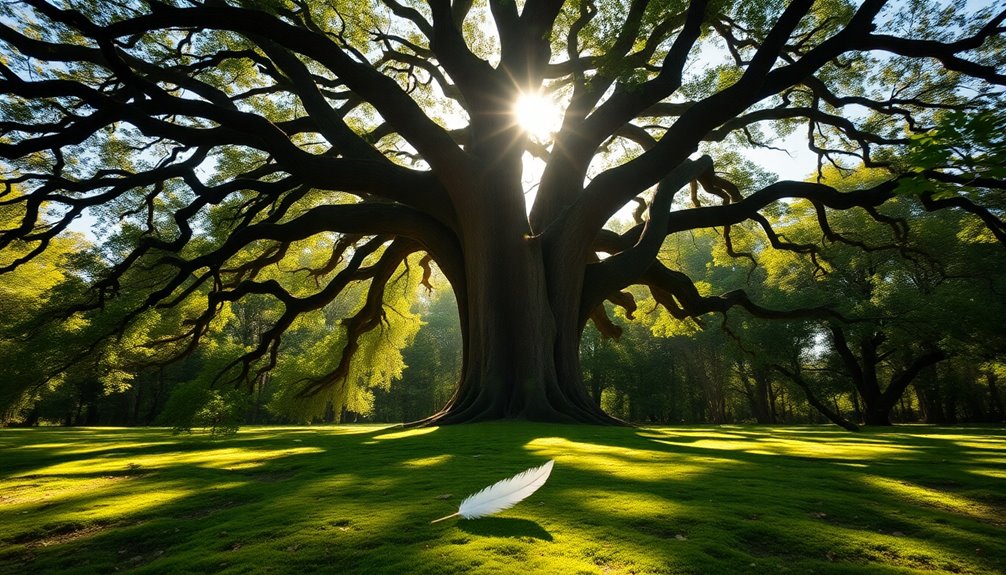Shirley Jackson uses symbolism in "The Lottery" to reveal deep truths about tradition and human nature. The black box stands for outdated customs, showing how people blindly follow practices without thinking. Stones symbolize the community's acceptance of violence, turning everyday objects into tools of cruelty. The marked slip of paper highlights how fate can be random and unfair, leaving anyone vulnerable to terrible outcomes. Together, these symbols encourage you to question traditions and their consequences. It's exciting to explore how Jackson's writing invites you to think about your own beliefs and the customs you see around you.
Key Takeaways
- The black box symbolizes the decay of tradition, illustrating villagers' blind loyalty to outdated customs without questioning their significance.
- The marked slip of paper represents fate's randomness, highlighting the arbitrary nature of violence within societal rituals.
- Stones serve as symbols of community complicity, showcasing how ordinary objects become instruments of brutality through collective acceptance.
- Jackson critiques conformity by demonstrating how unquestioned traditions can lead to horrific outcomes, normalizing violence within the community.
- The story encourages critical reflection on personal beliefs about tradition, prompting readers to examine the ethical implications of societal customs.
Overview of Symbolism
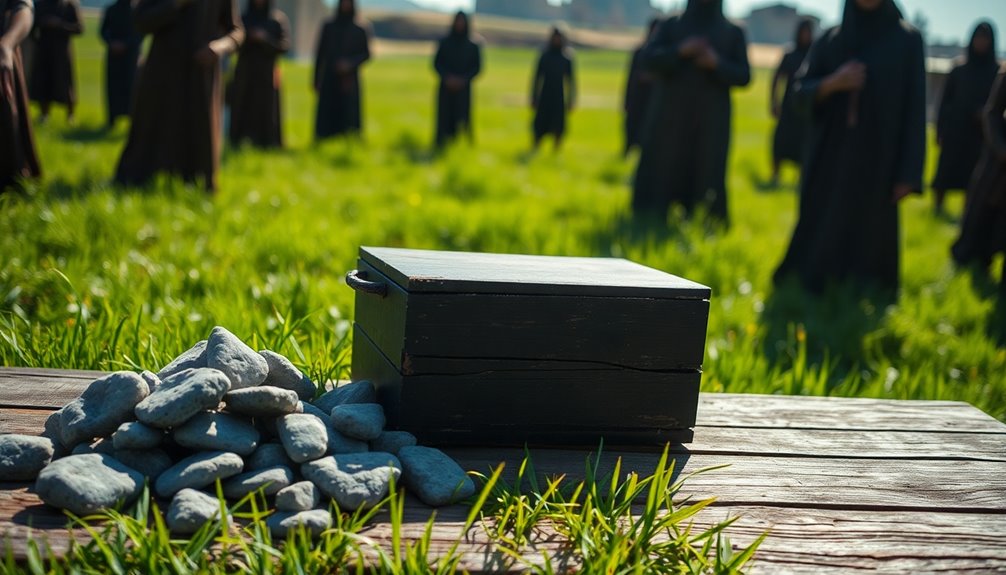
In Shirley Jackson's "The Lottery," symbolism plays a crucial role in conveying the story's deeper meanings about tradition and human nature. One of the most important symbols is the black box. This box represents the tradition of the lottery itself. Even though it's old and worn out, the villagers cling to it, showing their blind loyalty to outdated customs. They don't question why they continue this brutal ritual, even as the box decays.
Another powerful symbol is the stones, which stand for violence and community complicity. The townspeople gather these stones with a sense of normalcy, masking their brutal actions behind the ritual. The marked slip of paper also highlights the randomness of fate, emphasizing how violence can be arbitrary and unfair.
Through these symbols, Jackson invites you to reflect on your own beliefs and the traditions you follow. She critiques the dangers of conformity and encourages you to think about the moral implications of unexamined customs.
The Black Box Explained
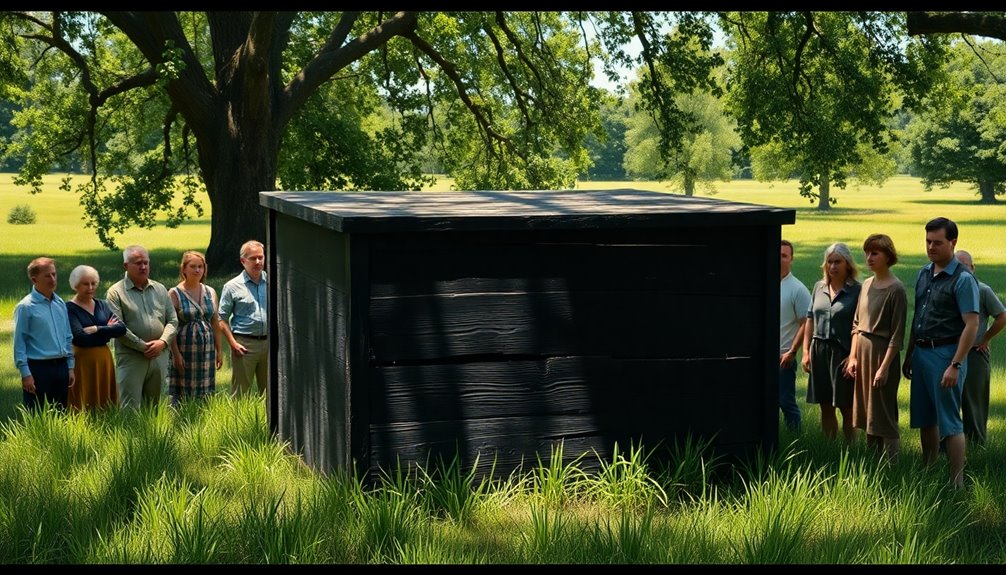
Let's take a closer look at the black box in "The Lottery."
This worn-out box shows how traditions can become old and dusty, just like the villagers' reluctance to change their ways.
Even though it's falling apart, the villagers cling to it, reminding us that sometimes, people hold on to customs that don't make sense anymore.
Decay of Tradition
The black box in Shirley Jackson's "The Lottery" serves as a powerful symbol of the decay of tradition within the village. You can see how its shabby and worn condition reflects the villagers' blind loyalty to customs that no longer hold meaning. Constructed from pieces of previous boxes, it represents the history of the lottery. This shows that traditions can become relics of the past, losing their significance over time.
The villagers refuse to replace the black box, which highlights their resistance to change. They cling to familiar practices, even when they don't make sense anymore. The faded appearance of the black box acts as a visual reminder of how society can stagnate. When people hold onto outdated traditions, it can lead to moral decay.
Their emotional attachment to the black box reveals the absurdity of their ritual. They uphold a symbol of violence without questioning its relevance. This symbolizes how traditions can trap individuals, making them forget the importance of change.
In this way, the black box not only embodies the decay of tradition but also invites you to reflect on the importance of questioning the customs that shape our lives.
Resistance to Change
Many villagers cling to the black box as a symbol of their unwavering loyalty to tradition, despite its worn and fragile state. This old box, made from pieces of previous boxes, shows just how deep their attachment runs. Even though it's falling apart, the villagers refuse to replace it. They believe this shabby box connects them to their past and justifies their yearly ritual.
But this blind loyalty can be dangerous. By holding onto the black box and its traditions, the villagers ignore the need for change. They don't stop to think about what they're doing. Instead, they participate in a brutal act without questioning why.
The black box serves as a reminder of how easily people can get stuck in old ways. It highlights that sticking to outdated traditions without examining them can lead to terrible outcomes. The villagers' refusal to change shows how tradition can sometimes trap people in a cycle of violence.
In the end, the black box not only symbolizes their past but also their struggle to evolve. So, what happens when people cling too tightly to tradition? It might just be time to rethink those old customs!
Significance of the Lottery

The lottery in Shirley Jackson's story is a powerful symbol of how people can blindly follow traditions, even when they lead to terrible outcomes.
It shows us how rituals can make violence feel normal, which is pretty unsettling!
Ritualistic Nature of Violence
While tradition often binds communities, Shirley Jackson's "The Lottery" reveals how such rituals can cloak violence and moral indifference. The annual lottery shows how the villagers blindly follow customs without questioning them. They gather around the black box, which holds slips of paper for the lottery, symbolizing an outdated tradition that no one dares to challenge.
As you read, notice how the act of stoning becomes a chilling highlight of the ritualistic nature of violence. It's a brutal act, yet the villagers participate without hesitation. This communal involvement illustrates how society can hide darker impulses behind a mask of normalcy.
When Tessie Hutchinson is chosen, the randomness of her fate reminds you that anyone can become a victim. The lottery changes from a simple event to something shocking and horrific. You see how following traditions without thought can lead to terrible outcomes.
This story teaches us about the dangers of conformity and how easily people can accept violence as part of their lives. So, as you reflect on "The Lottery," consider how rituals can sometimes disguise the true cost of tradition.
Tradition vs. Progress
In Shirley Jackson's "The Lottery," the black box stands as a stark reminder of how tradition can hinder progress. This old, shabby box symbolizes the villagers' blind adherence to their customs. Even though it's falling apart, they refuse to contemplate a change.
Why? They believe that sticking to their tradition is essential, just like Old Man Warner says, "Lottery in June, corn be heavy soon." He thinks this ritual is necessary for a good harvest, even if it costs lives.
As you read, notice how the marked slip of paper represents the randomness of the lottery. It shows how people are sacrificed for outdated practices without questioning their worth.
The story challenges you to think about the dangers of conformity. It asks if clinging to traditions is really worth it when they lead to violence and suffering. Additionally, the narrative serves as a cautionary tale about the importance of shared values and goals in fostering a more thoughtful and compassionate community.
Stones as Symbols of Violence

Stones emerge as powerful symbols of violence in Shirley Jackson's "The Lottery," transforming from mere objects into instruments of brutal execution. At first glance, they seem like everyday items, just simple rocks. But once you see how the villagers use them, their true meaning becomes clear. The act of stoning shows the community's acceptance of violence as a normal part of their lives. This collective behavior highlights how even ordinary people can take part in horrific acts when society says it's okay.
The stones represent a dark side of humanity. As you read, you might feel the tension building, knowing that these simple objects become tools of savagery. The villagers don't just throw the stones; they participate in a ritual that connects them to their history, even if it's a brutal one. This shows how traditions can sometimes lead to violence, and it forces you to think about how customs shape our actions.
The Role of the Marked Slip
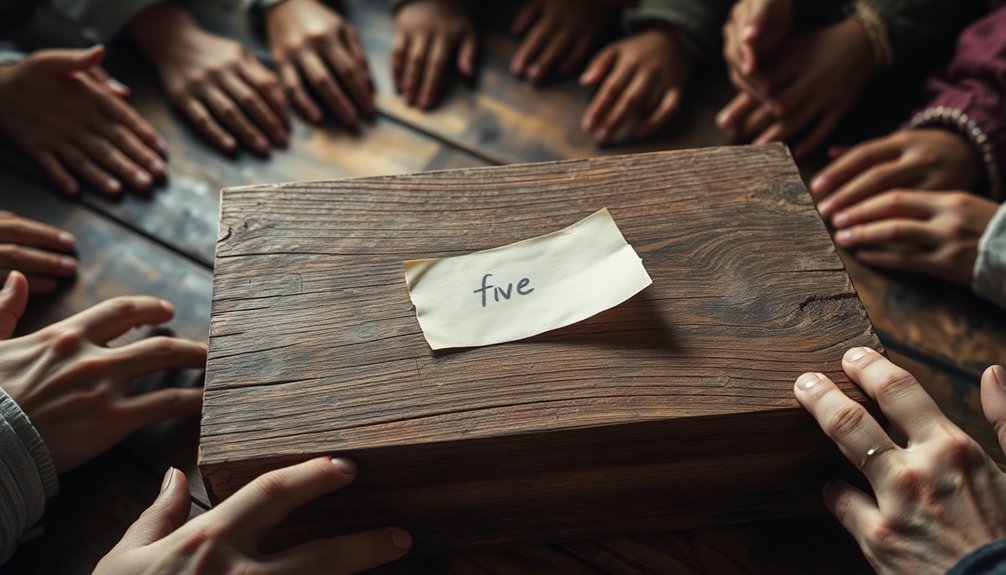
In "The Lottery," the marked slip of paper plays a big role in showing how fate can pick anyone for something terrible.
When someone draws that slip, it brings feelings of stigma and isolation, making them feel like an outcast in their own community.
This little piece of paper turns into a powerful symbol, reminding us how easily people can follow traditions without questioning them.
Symbol of Fate
The marked slip of paper in Shirley Jackson's "The Lottery" serves as a chilling symbol of fate, representing how randomness can govern life and death. Each villager enthusiastically draws from the black box, hoping for a blank slip. But only one marked slip, with a dark spot, seals a terrible fate. This randomness shows how violence can creep into everyday life, striking without warning.
The marked slip also highlights how society often scapegoats individuals. It doesn't matter who you're or what you've done; once you're marked, you become an object of community judgment. The excitement of the lottery quickly shifts to tension as everyone realizes the stakes. You can almost feel the weight of the moment when someone draws that slip.
In this ritual, the marked slip transforms a person into a symbol of fate, emphasizing how chance can dictate our lives. It's a reminder of how easily we can overlook individual identity when faced with communal expectations.
The slip acts as a catalyst for the villagers' actions, showing how quickly a simple tradition can lead to tragic outcomes. It's a powerful exploration of fate, community, and the darker sides of human nature.
Stigma and Isolation
Marked by a dark blemish, the slip of paper in "The Lottery" encapsulates the stigma and isolation faced by its unfortunate bearer. When someone draws the marked slip, everything changes. This slip doesn't just mean bad luck; it represents a cruel twist of fate. Here's how it plays a crucial role:
- Stigma of Sacrifice: The marked slip shows how society blames one person for the group's troubles, creating a heavy burden.
- Isolation from Community: The chosen individual becomes an outcast, targeted for violence while everyone else watches.
- Scapegoating: This slip symbolizes how communities can unfairly punish the innocent, ignoring their humanity.
- Randomness of Violence: The violence isn't personal; it's a ritual, highlighting how people can accept cruelty without questioning it.
Tessie Hutchinson, the marked one, faces profound isolation and stigma. As her fate unfolds, she becomes a symbol of the tragic consequences of blind tradition.
In this way, the marked slip not only highlights the darkness within the community but also serves as a reminder of the painful isolation that can come from being singled out.
Seasonal Symbolism in the Story
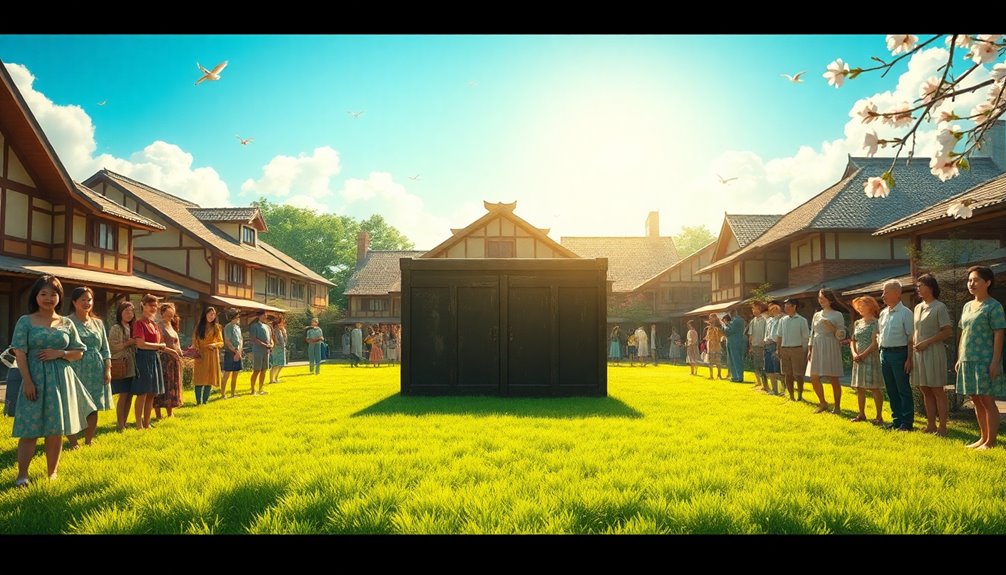
Shirley Jackson skillfully employs seasonal symbolism in "The Lottery," with the story unfolding on June 27, a date that heralds the height of summer. Summer is often a time of growth, warmth, and joy. The villagers gather under the bright sun, creating an atmosphere that feels festive and inviting. You might expect a celebration, but things take a dark turn.
Mr. Summers, who oversees the lottery, embodies the spirit of this season. However, he stands next to the black box, a symbol of death and violence. This contrast between the sunny setting and the grim lottery highlights the story's shocking outcome. The villagers, excited and enthusiastic, believe the lottery will help their crops thrive, linking their tradition to the season's promise of fertility.
Yet, this connection reveals a deeper issue. The cheerful imagery of summer masks the horror of the stoning that follows. Jackson uses this seasonal symbolism to show how the villagers cling to unexamined traditions, even when they lead to terrible consequences.
Irony in Ritual Practices
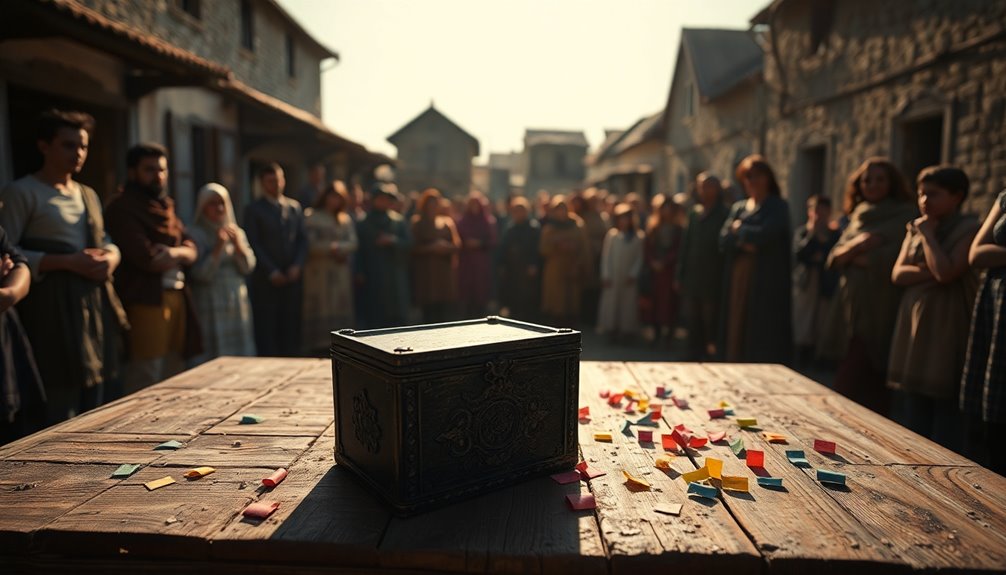
Amid the festive atmosphere of the lottery, an unsettling irony unfolds, as what begins as a celebration quickly devolves into a brutal act of violence. You might expect joyous cheers, but instead, the villagers engage in a shocking ritual.
Shirley Jackson cleverly shows us how traditions can mask dreadful realities. Here are some key points to reflect upon:
- The lottery, seen as a positive event, ends in a horrifying stoning, flipping our expectations upside down.
- Old Man Warner believes the lottery keeps civilization intact, yet it highlights the savage practices hidden beneath societal norms.
- As the villagers smile and laugh, the grim outcome reveals the dark irony of their cheerful facade.
- Even children take part in the stoning, showing how innocence can be twisted by the group's violent customs.
The black box, used to hold the marked slips of paper, symbolizes the randomness of fate, turning what seems like a game into a chilling execution.
This juxtaposition of celebration and horror truly emphasizes the irony in the lottery, reminding us that not all traditions are as innocent as they appear.
Themes of Tradition and Change

In many communities, traditions are often followed without question, even when they lead to dire consequences. In Shirley Jackson's "The Lottery," you see how the villagers cling to a ritual that brings harm, all because it's been done for so long. The black box used in the lottery symbolizes this outdated tradition. It's old, worn, and represents how people hold onto customs even when they no longer make sense.
Old Man Warner, a character in the story, believes that these traditions are crucial for the community's survival. He's resistant to change, thinking that without this ritual, society would crumble.
But Tessie Hutchinson's tragic end shows just how dangerous this blind adherence can be. Her fate serves as a powerful reminder of the consequences of following harmful traditions without questioning them.
Jackson's story encourages you to think about the importance of change and the need to challenge inherited customs. By examining the traditions in "The Lottery," you learn that it's important to evaluate whether they're truly beneficial or just a way to perpetuate violence.
Embracing change can lead to a better understanding of what truly matters in a community!
Community Complicity in Violence

The villagers' collective participation in the stoning of Tessie Hutchinson starkly illustrates their complicity in violence, highlighting how tradition can overshadow morality. They follow the ritual blindly, without asking if it's right. This shows how dangerous it can be to stick to old ways.
Here are some key points to reflect on:
- The black box symbolizes the community's adherence to outdated traditions, reminding everyone of their shared guilt.
- Stones serve as weapons, representing the primal and brutal nature of human actions, which are normalized in this society.
- Children gather stones with adults, showing how violence can be taught and accepted from a young age.
- Lack of remorse during the stoning reveals a desensitization to violence, demonstrating how community dynamics can support such horrific acts.
As you read, think about how this community complicity in violence affects everyone involved.
It's a powerful reminder of how easily people can accept traditions that harm others. Understanding this helps you see the importance of questioning our own traditions and values.
What do you think about the choices the villagers made?
Impact of Symbolism on Readers
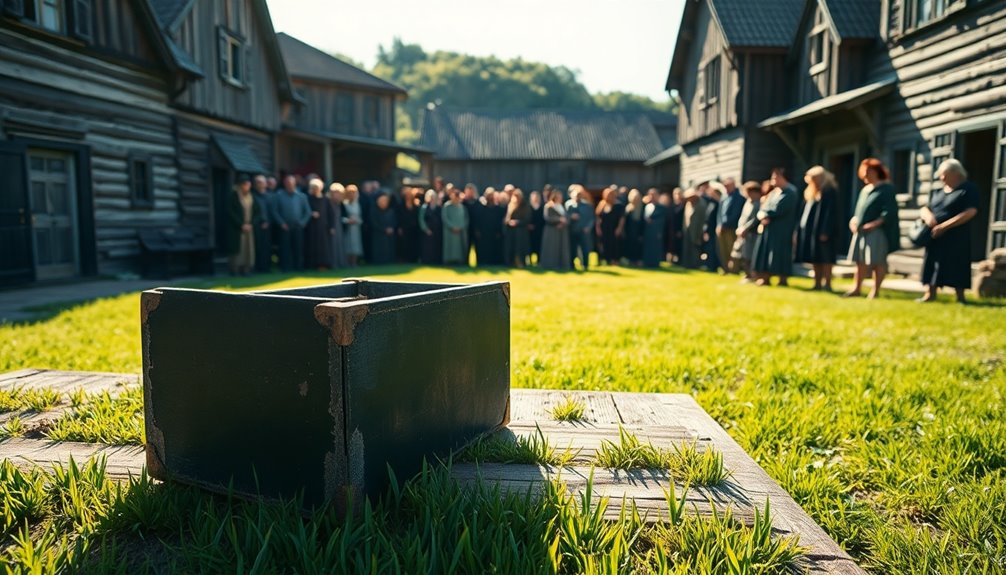
Shirley Jackson's masterful use of symbolism in "The Lottery" profoundly impacts readers, compelling them to confront unsettling truths about tradition and violence. The black box, worn and tattered, symbolizes the decay of tradition. When you see it, it might make you feel uneasy. This feeling encourages you to think about the dangers of sticking to outdated customs without questioning them.
Then there are the slips of paper. One marked slip represents fate and the community's choice to scapegoat individuals. This part deepens your emotional response, showing how violence can be random and arbitrary. It's chilling to realize how easily people can turn on each other.
Jackson's vivid imagery, especially with stones, forces you to face the harsh reality of communal violence. You might feel horror and repulsion while reading.
The symbolism in "The Lottery" doesn't just tell a story; it invites you to think critically about our own societal practices. It leaves you with a lingering sense of unease about conformity and tradition.
Frequently Asked Questions
What Are the Symbols Used in the Lottery by Shirley Jackson?
In "The Lottery," Shirley Jackson uses several symbols that really stand out.
The black box represents old traditions, showing how people stick to outdated customs.
Stones symbolize the violence of the community, reminding us of the harshness of their actions.
The marked slip of paper highlights how random fate can be.
Mr. Summers, who runs the lottery, contrasts the idea of summer's growth with dark outcomes.
Each symbol adds depth to this chilling story!
Which of the Following Is an Example of Symbolism in the Lottery?
Imagine a dark cloud hovering over a cheerful village. In "The Lottery," symbols reveal deeper meanings.
One example is the black box, worn and shabby, showcasing how the villagers cling to outdated traditions. It's like a faded photograph that no one wants to replace!
Another symbol is the slips of paper, representing chance in a game where fate decides who faces the harsh consequences.
These symbols help you understand the villagers' strange customs and beliefs.
What Does Tessie Symbolize in the Lottery?
In "The Lottery," Tessie Hutchinson symbolizes the harsh consequences of following traditions without questioning them.
At first, she seems relaxed, but when she becomes the victim, her fear shows how unfair the system can be. Tessie's plea for fairness highlights the struggle between what's right for individuals and what society expects.
Her experience reminds us to think critically about our customs, so we don't fall into the trap of blind conformity.
What Does Martin Symbolize in the Lottery?
In "The Lottery," Martin represents how people can blindly follow traditions without questioning them.
You see, he helps with the lottery, showcasing how society can normalize violence when everyone participates.
His character reminds you that even the younger generation can get caught up in harmful customs.
Conclusion
Shirley Jackson's "The Lottery" is full of symbols that make you think. Did you know that in some cultures, about 70% of people still follow traditions without questioning them? That shows how powerful tradition can be! The black box, the stones, and the marked slip all remind us of how easily communities can accept violence. By exploring these symbols, you get to see the deeper meaning behind the story. Isn't it exciting to discover that?

